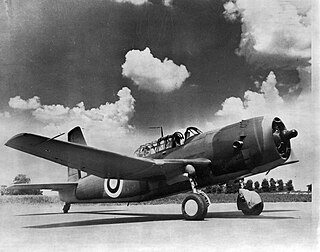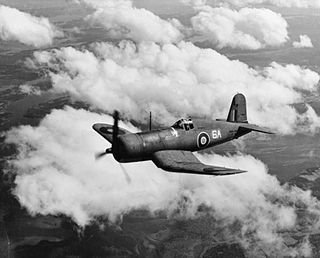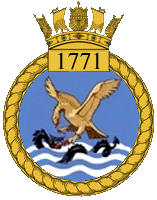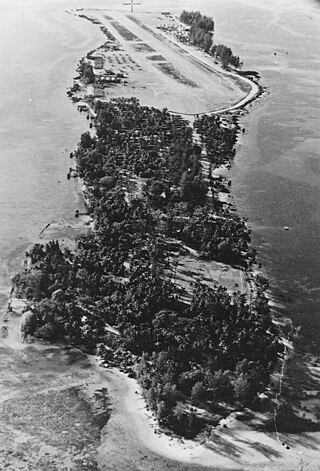
The Mobile Naval Airfield Organisation (MNAO) was the shore-based component of the naval air logistics organisation. This comprised two types of units, a Mobile Operational Naval Air Base (MONAB) and a Transportable Aircraft Maintenance Yard (TAMY). These were mobile units, the first of which formed in 1944, to provide logistical support to the Fleet Air Arm squadrons of the Royal Navy's British Pacific Fleet, towards the end of World War II.
HMS Nabberley was a Royal Navy (RN), Mobile Operational Naval Air Base (MONAB) at the Royal Australian Air Force (RAAF) base RAAF Bankstown located at Bankstown, New South Wales, Australia. HMS Nabberley was also known as MONAB II and Royal Naval Air Station Bankstown.
HMS Nabthorpe was a Royal Navy, (RN), Mobile Operational Naval Air Base (MONAB) situated at the Royal Australian Air Force (RAAF) base RAAF Station Schofields located at Schofields, New South Wales during the final year of the Second World War. HMS Nabthorpe was also known as MONAB III and Royal Naval Air Station Schofields.

778 Naval Air Squadron was a Naval Air Squadron of the Royal Navy's Fleet Air Arm. During the Second World War the squadron was a Service Trials Unit (STU) initially based at HMS Daedalus, RNAS Lee-on-Solent, Hampshire, England before moving to HMS Condor, RNAS Arbroath, Angus, Scotland on 6 July 1940. The squadron tested all types of aircraft that could be used by the Royal Navy. Key to this was testing new types for deck landing on aircraft carriers. Such aircraft included various types of Supermarine Seafires, Grumman Hellcats, Grumman Martlets, Grumman Avengers, and Vought Corsairs. The squadron was reformed on 5 November 1951 with Douglas Skyraider AEW.1 but was disbanded on 7 July 1952 to form the basis of 849 Naval Air Squadron.

706 Naval Air Squadron was a Naval Air Squadron of the Royal Navy's Fleet Air Arm. Established as a fighter and torpedo-bomber training unit in Australia at the end of World War Two, it was briefly reformed as a helicopter squadron in the early 1950s, before becoming a helicopter training unit in 1962, and operating until 1998.

885 Naval Air Squadron was a Naval Air Squadron of the Royal Navy's Fleet Air Arm. First formed on 1 March 1941, the squadron served as a fighter squadron during the Second World War. It operated in the Mediterranean in 1942–43, where it took part in Operation Torch, the Anglo-American invasion of French North Africa, the Allied invasion of Sicily and the Allied invasion of Italy. In 1944 it took part in the Allied invasion of Normandy, spotting for Allied artillery bombardments and in 1945, was deployed as part of the British Pacific Fleet. It was abolished for the last time on 27 September 1945.

721 Naval Air Squadron was a Naval Air Squadron of the Royal Navy's Fleet Air Arm (FAA). 721 Naval Air Squadron formed at HMS Gadwall, RNAS Belfast, Northern Ireland, at the beginning of March 1945, as a Fleet Requirements Unit for the British Pacific Fleet. Initially equipped with Vultee Vengeance target tugs, it arrived at HMS Nabaron, RNAS Ponam, Admiralty Islands in May 1945, and commenced operations towing targets. The squadron moved to HMS Nabsford, RNAMY Archerfield, Brisbane, Australia, during October and then relocated to Hong Kong at the beginning of 1946, moving to HMS Nabcatcher, RNAS Kai Tak, where it eventually disbanded at the end of 1947.

732 Naval Air Squadron was a Naval Air Squadron of the Royal Navy's Fleet Air Arm (FAA). It was initially formed in 1943 from a requirement for an Operational Training Unit for United States trained FAA pilots flying Vought Corsair fighter-bomber aircraft, at RN Air Section Brunswick, USNAS Brunswick, Maine, United States, and disbanded during 1944. In 1945 it was reformed for a brief period, as a Night Fighter Training Squadron, operating out of HMS Nighhawk, RNAS Drem, East Lothian, Scotland. Notably equipped with six Avro Anson 'flying classrooms', amongst other aircraft.

757 Naval Air Squadron was a Naval Air Squadron of the Royal Navy's Fleet Air Arm. It was first formed as a Telegraphist Air Gunner Training Squadron in 1939, operating out of RNAS Worthy Down, but after three months it went into abeyance, only to reform again in the same role, at the same location, in 1941 and operating until 1942. It then reformed as a Fighter Pool Squadron & Operational Training Unit at RNAS Puttalam, in Sri Lanka, in 1943. After a brief spell at RNAMY Tambaram, in India, the squadron finally disbanded at RNAS Katukurunda, in Sri Lanka, at the beginning of 1946.

768 Naval Air Squadron was a Naval Air Squadron of the Royal Navy's Fleet Air Arm (FAA). It last disbanded at HMS Gannet, RNAS Eglinton, Northern Ireland, in March 1949, having been formed as a Deck Landing Control Officer Training Squadron, in December 1948, to ensure one American-style signal trained DLCO could be located at every FAA station. It first formed as part of the Deck Landing Training School at HMS Condor, RNAS Arbroath, in January 1941, as a Deck Landing Training Squadron. Advanced training was in HMS Argus, for which a detachment was maintained at HMS Landrail, RNAS Machrihanish, where it wholly moved to in March 1943. September saw a move to RAF Heathfield, Ayr, followed by a further move to HMS Sanderling, RNAS Abbotsinch in January 1944. Training used escort carriers on the Firth of Clyde and a detachment was maintained at (Heathfield)Ayr throughout this period, with the squadron returning there in July 1945, at this time HMS Wagtail, RNAS Ayr. In August the squadron moved to HMS Corncrake, RNAS Ballyhalbert in Northern Ireland but then in October it joined up with the Deck Landing School at HMS Peewit, RNAS East Haven, Scotland, where it disbanded in April 1946.

787 Naval Air Squadron was a Naval Air Squadron of the Royal Navy's Fleet Air Arm which disbanded in January 1956. It formed in March 1941, at HMS Heron, RNAS Yeovilton, out of 804 Naval Air Squadron as a Fleet Fighter Development Unit. Almost every type of fighter was received by the squadron for testing and evaluation for naval use. A move to RAF Duxford in June 1941 saw it become the Naval Air Fighting Development Unit, attached to the Royal Air Force's Air Fighting Development Unit. The squadron undertook rocket projectile test, continuous development of fighter tactics and even helping Torpedo Bomber Reconnaissance squadrons in evading fighter attack. Post Second World War it continued its trials task and also undertook Rebecca radar trials and ASH, US-built air-to-surface-vessel radar trials.

797 Naval Air Squadron was a Naval Air Squadron of the Royal Navy's Fleet Air Arm which last disbanded in October 1945 in Ceylon. Its role was a Fleet Requirements Unit which formed at HMS Ukussa, Royal Naval Air Station Katukurunda, in Ceylon, in July 1942. The squadron moved to RNAS Colombo Racecourse in October 1943. It had a Communications Flight which became 742 Naval Air Squadron in December 1943 and the following summer it had an ‘X’ Flight deployed for target towing for a couple of gunnery schools in Bombay, India and which eventually moved to 722 Naval Air Squadron.

1771 Naval Air Squadron was a Naval Air Squadron of the Royal Navy's Fleet Air Arm which disbanded at HMS Nabbington, RNAS Nowra, near Sydney, in October 1945. Notably, the squadron was the first British & Commonwealth unit to fly over Japan in the Second World War. The squadron formed at HMS Heron, RNAS Yeovilton at the start of February 1944, as a Fighter Squadron and also operated from HMS Ringtail, RNAS Burscough, and HMS Landrail, RNAS Machrihanish, with deck landing training on the escort carriers HMS Trumpeter and HMS Ravager before embarking in the fleet carrier HMS Implacable in September. It was involved in sorties over Norway including reconnaisance of the German battleship Tirpitz and other anti-shipping strikes. The squadron remained in HMS Implacable and joined the British Pacific Fleet participating in attacks on the Caroline islands and the Japanese home islands, and becoming part of the 8th Carrier Air Group.
1843 Naval Air Squadron was a Naval Air Squadron of the Royal Navy's Fleet Air Arm between 1943 and 1945 and then a Royal Naval Volunteer Reserve Air Squadron from 1953 to 1957. It formed in the United States at RN Air Section Brunswick, in May 1944, as a fighter squadron. It arrived in the UK aboard HMS Trouncer in August. Based at HMS Gannet, RNAS Eglinton, Northern Ireland and training at HMS Wagtail, RNAS Ayr, Scotland, the squadron had deck landing training aboard HMS Patroller in December, before joining HMS Arbiter in February 1945, as part of the 10th Naval Fighter Wing. Sailing to Australia, the squadron became part of the 3rd Carrier Air Group, but saw no action before the war ended and disbanded in October 1945. It reformed as a Royal Naval Volunteer Reserve Air Branch anti-submarine squadron, in the Scottish Air Division, from 1953 and disbanded in 1957.

1844 Naval Air Squadron was a Naval Air Squadron of the Royal Navy's Fleet Air Arm between 1943 and 1945 and then a Royal Naval Volunteer Reserve Air Squadron from 1954 to 1957. It formed in Northern Ireland at HMS Gannet, RNAS Eglinton, in December 1943, as a fighter squadron. It embarked in HMS Begum, in February 1944, for the Far East, arriving in Ceylon, in June and joining HMS Indomitable the following month. August, September and October saw the squadron undertake photographic reconnaissance and provide fighter cover for the attacks on Indaroeng and Emmahaven in Sumatra, then on Sigli, followed by the Nicobar Islands respectively.

1845 Naval Air Squadron was a Naval Air Squadron of the Royal Navy's Fleet Air Arm. It formed at RN Air Section Brunswick, United States, in June 1944 as a fighter squadron, with eighteen Vought Corsair Mk III fighter aircraft. It embarked in HMS Puncher on 30 August, disembarking to HMS Gannet, RNAS Eglinton, Northern Ireland, on 18 September and joining the 10th Naval Fighter Wing. It re-equipped with twenty-four Vought Corsair Mk IV, and embarked HMS Slinger in December, sailing for the British Pacific Fleet, the squadron was disbanded in April 1945, and its aircraft and personnel absorbed into squadrons aboard the aircraft carriers HMS Formidable and HMS Victorious. On 1 June it reformed in Australia as a single seater fighter squadron at HMS Nabsford, RNAMY Archerfield, Queensland, and it shortly later became a spare squadron in the 3rd Carrier Air Group at HMS Nabbington, RNAS Nowra, New South Wales. With the end of the Second World War the squadron disbanded on 24 October.

1846 Naval Air Squadron was a Naval Air Squadron of the Royal Navy's Fleet Air Arm. It formed at RN Air Section Brunswick in July 1944 as a fighter squadron, with eighteen Vought Corsair Mk III fighter aircraft. It embarked in HMS Ranee in October, disembarking to HMS Gannet, RNAS Eglinton at the beginning of November, where it expanded to twenty-four aircraft by absorbing part of the disbanded 1848 Naval Air Squadron. In February 1945, it re-equipped with Vought Corsair Mk IV, having joined HMS Colossus at the start of the year. The aircraft carrier departed for the Far East in February, and its aircraft formed part of the 14th Carrier Air Group when this formed in June at HMS Valluru, Royal Naval Aircraft Maintenance Yard Tambaram. The squadron was too late for World War II, and eventually disbanded at HMS Siskin, RNAS Gosport, in July 1946.

Royal Naval Air Station Twatt, is a former military airfield, located near Twatt, Orkney, Scotland, of the Royal Navy. It was built by the Admiralty and was commissioned on 1 April 1941. On 1 January 1942 it became an independent command as HMS Tern. The airbase was designed to provide accommodation for disembarked Front-Line squadrons and accommodation for disembarked Ship's Flight Aircraft and was home to the Home Fleet Fleet Requirements Unit, 771 Naval Air Squadron.

HMS Nabaron was a Royal Navy (RN) Mobile Operational Naval Air Base (MONAB) which was situated at the United States Navy (USN) airfield NAS Ponam Airfield on Ponam Island, Admiralty Islands in Papua New Guinea, which had been transferred to RN on loan. HMS Nabaron was also known as MONAB IV and Royal Naval Air Station Ponam.



















